| - | | - | | - | | - | | - | | - | | - | | - | | - | | - | | - | | - | | - | | - | | - | | - | | - | | - | | - | | - | | - | | - | | - | | - | | - | |
Western Abenaki Moons
LES TREIZE LUNES ABÉNAKISES PAR CHRISTINE SIOUI WAWANOLOATH
THE THIRTEEN WABANAKI MOONS BY CHRISTINE SIOUI WAWANOLOATH
NS8KAW 8BANAKI KIZOSAK KIZIT8GW KLISTIN SIOUI WAWANOLOATH
The names of the moons in French do not always correspond to the English ones. For example Pia8dagos in French means Old moon and storm moon. It is because the sources naming the moons were different in French and English.
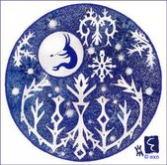 |
1 Décembre / December
Pebonkas Jeune lune d’hiver (Young Winter moon)
Des cristaux de neige ressemblent à des doubles courbes.
Le lièvre fume sa pipe dans la lune. Tout est calme.
Pebonkas (Winter Maker Moon)
Snow crystals look like double curve motifs. Hare is smoking his pipe in the moon. Everything is tranquil.
Pson n8bi bitaw8wi8n8gwat. Mategwas odama w'senip8gan p8gwasek. Msizaz8genawi.
|
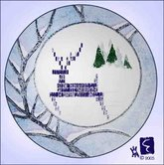 |
2 Janvier / January
Alamikos Deuxième lune d’hiver (Second Winter moon)
Le chevreuil de perles mauves de wampum file comme le vent.
Alamikos (Greeting Maker Moon)
The wampum deer of purple beads runs swiftly like the wind.
W8b8binolka wji wl8wimoz8bial gagezihl8b n8bi al8msek.
|
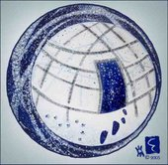 |
3 Février / February
Pia8dagos Vieille lune et lune des tempêtes
Le blizzard tourbillonne autour du wigwam lunaire qui accueille les pas des humains. Ceux de l’animal ne font que passer.
Pia8dagos (Makes Branches Fall Into Pieces Moon)
The blizzard whirls round the wigwam greeting human steps. Those of the animal are only passing by.
Tatkal8msen bedegwel8msen wiwniwigw8m alamipm8ssawinnoak. Nigik wji awaasak ibitta w'bemikamak.
|
 |
4 Mars / March
Mozokas Lune de l’orignal (Moose moon)
La lune à panache rayonne. La peau d’orignal est peinte de motifs traditionnels.
Mozokas (Moose Hunter Moon)
The antler moon shines. The moose skin is painted with traditional patterns.
Askan p8gwasoo. Mozagen aln8bailow8wzoisezow8zo.
|
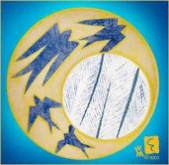 |
5 No corresponding month
Sigwankas Lune du retour des oiseaux (Birds Returning Moon)
Un oiseau ancien, en cuivre natif, a inspiré ce tableau du retour des oiseaux. Des plumes, agrandies des centaines de fois, révèlent une lune bleutée.
Sigwankas
An ancient bird, made of Native copper, inspired this painting telling the return of the birds. Feathers, magnified hundredfold times, reveal a bluish moon.
n8wad sibs, kiziton wji aln8baianaskam8n, wawtamikha io sezoha l8dokamek pedgiak wji sibsak. Migwenok, p8paami msin8gwad, kinamothla alwa wl8wigizos.
|
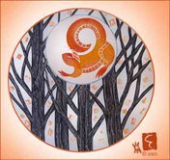 |
6 Avril / April
Sogalikas Lune du sucre (Sugar Maker Moon)
Dans la légende, l’écureuil roux recueille l’eau d'érable. Son pelage est décoré de motifs traditionnels. Les cristaux de sucre ornent le ciel.
Sogalikas (Sugar Maker Moon)
In the legend, red squirrel collects maple sap. Its fur is ornamented with antique patterns. Sugar crystals adorn the sky.
neg8n8jemow8ganek, mikoa makwigid pkamhiga. Wito l8mpskaihan spiwi n8wad lawigh8zoal. Sogalis8bon mawian spemki.
|
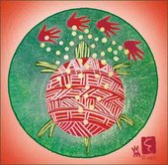 |
7 Mai / May
Kikas Lune de la terre (Earth moon)
La Tortue (la Terre) est sillonnée de motifs trouvés sur les poteries anciennes. Ils représentent le labourage de la terre. On peut alors l’ensemencer.
Kikas (Field Maker Moon)
Turtle (the earth) is lined with traditional patterns carved on ancient pottery. They represent ploughing. Sowing begins.
Tolba (ahki) bitogw8ns8gan aln8bailow8wzolawigh8zoal awigha n8wad wskidskw8latakamek. Kinamothla lakaz8mek. Kika m8jato.
|
 |
8 Juin / June
Nokahigas Lune des petites fraises et de l’écorce (Small strawberries and leaves moon)
Les petites fraises poussent en un motif de doubles courbes. La lune est faite d’écorce. Le grand pic à huppe rouge vaque à son occupation.
Nokahigas (Hoer Moon)
Wild strawberries grow into a double curve design. The Moon is made of bark. The woodpecker, with its red tuft, is tending to business.
Pizwakamigw mskikoiminsak m8jagiak li bitaw8wi8gan lawigh8zo. P8gwas kiziton wji walaga. 8basas, spiwi agma mekwimigwenol, w'z8balokamek.
|
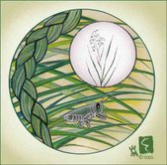 |
9 Juillet / July
Temaskikos Lune de la cueillette du foin d’odeur.
Le foin odorant ondule dans le vent. Une sauterelle se repose sur un brin d'herbe. On fera des tresses de foin.
Temaskikos (Grass Cutter Moon)
Sweetgrass waves with the wind. grasshopper rests upon a blade of grass. Sweetgrass braids will be made.
Wlim8kilmskikoal bemel8msen. ch8ls 8dabi wskidmskiko. Wlim8kilmskik8bagenaak wlitojiak.
|
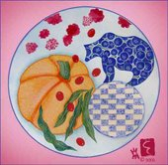 |
10 Août / August
Temez8was Lune des récoltes
L’ours noir raffole des bleuets. La citrouille, les fèves, les framboises et les atocas tombent du ciel.
Fruits et légumes seront déposés dans des paniers.
Temez8was (Cutter Moon – refers to harvesting)
Black bear is so fond of blueberries. Pumpkin, beans, raspberries and cranberries are falling from the sky. Fruits and vegetables will be put into baskets.
Awasos w'gezaldamenal satal. Wasawal, adebakwal, zegweskimenak ta popokwaimenal banihlaak wji spemki. Mink8ganak ta agwizijik sapkwaakji nodaikok.
|
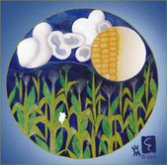 |
11 Septembre / September
Skamonkas Lune du maïs
Le champ de maïs est prêt pour la récolte. La lune veille. La souris aussi.
Des nuages de maïs soufflé flottent dans le ciel.
Skamonkas (Corn Maker Moon)
The corn field is ready for harvesting. The moon is standing by. So is mouse. Clouds of popcorn drift in the sky.
Skamonikik8n gatata kikaw8ganal. Nanip8nsat wd'askaw8bimek. Achi w8bikwsos. W8basokwak wji kakikws8zo bemel8msen spemkik.
|
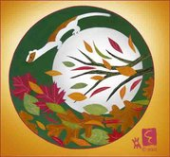 |
12 Octobre / Octobre
Penibagos Lune des échanges et des feuilles qui tombent (Exchange and falling leaves moon)
La belette échange sa fourrure sombre pour un manteau d’hiver.
Le vent éparpille les feuilles.
Penibagos (Leaf Falling Moon)
Weasel sheds its dark fur for a winter coat. The wind scatters the leaves.
Sagwasiz waniado wito wji w'peponito. Tkel8msen sisa8boal wanibagol.
|
 |
13 Novembre / November
Mzatanos Lune de l’eau qui fige en glace
L’eau se fige en glace, l’esprit du castor se repose.
Son corps nourricier ne survivra peut-être pas au-delà de cette époque.
Mzatanos (Freezing River Maker Moon)
Water turns into ice, the spirit of beaver is resting. Its nourishing flesh may not survive beyond this season.
Nebihla pkwami, niwaskw wji temakwa 8dabi. Wliwios kizilla nda oz8l8wziw awassiwi akw8bakka.
|
Our greatest thanks go out to Christine Sioui Wawanoloath for giving us permission to use her beautiful artwork and descriptions of each peice as learning tools within out site! Kchi wliwni! Her "Thirteen Wabanaki Moons" can also be seen on display at the Odanak Museum.
More Moons: The year is commenced from the new moon preceding Christmas. Months are counted by new moons, and the first day of each new moon is the first day of the month. There is also a name for each full moon. Each new moon is 14 days (2 weeks) and each full moon is a 14 days with 28 days in each complete cycle of the moon. As in some years there are thirteen moons (26 counting new and full moons), then the Abenakis skip the new and full moons between July and August, and they call this tradition Abonamwikizos (let this moon go), it is used like the modern leap year to keep the calender on track. Below you will notice that there are, in some cases, several names for the same moons. All are acceptable in the language and its usually up to the speaker to decide which is to be used, however some are used dependant on setting or region. In addition, as described above, moons do not all cover the same periods of time. Some are shorter than a month, while others are longer, others are names specifically for the full moon during a given month, others are names of specific celebrations during a moon. Also included below are literal translations with additional meanings in paranthesis. Some have several possible translations, all of which could be correct as Western Abenaki names often have more than one meaning.
|
Alamikos ala Anhaldamawikizos - Greetings Maker or Forgiveness Moon | January |
|
Pia8dagos - Falling in pieces Branches Maker | February |
| Sigwankas ala Sigwanikizosak - Spring Maker (birds return maker, melt maker) or Spring Moons | March, April and May |
| Mozokas - Moose Maker (hunter) | March |
| Sogalikas ala Sogalikizos ala 8maswikizos - Sugar Maker or Sugar Moon or moon when we catch fish | April (Formerly called Mekwaskwikizos (the Great Cold Moon); but since the Abenaki were deprived of their rich settlements on the Kennebec, it has been changed). |
| Kikas or Kikaikizos - Field Maker or Moon in which we plant (the planter) | May |
| Nokkahigas ala Mskikoikas - the Hoer or Strawberry Moon (Full Strawberry Moon) | June |
| Temaskikos ala Sataikas ala Pad8gikas - Hay Cutter or Blueberry Maker or Thunder Moon (name of the Full Moon) | July |
| Mijow8gankas ala Michinikizosak - Meal Maker or Eating Moons | August and September |
| Temez8was ala Kawakwenikas - Harvester (cutter) or Gatherer (wild harvester) | August |
| Skamonkas - Corn Maker | September |
| Penibagos - Leaf Fall Maker | October |
| Mezatanos ala Mezatanokas - Freezing Current (river) One or Freezing Current Maker | November |
| Pebonkas ala Kchikizos - Winter Maker or Great Moon | December |
|
|
WesternAbenaki.com Copyright 2009
|






















